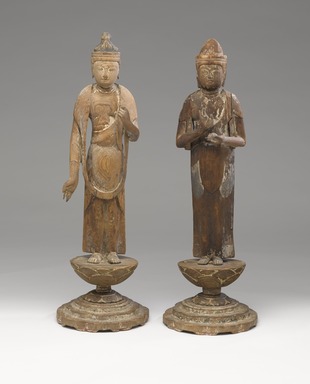
Medium: Wood, gesso, and paint
Geograhical Locations:
Dates:ca. 1100
Dimensions: 19 x 6 1/4 in. (48.3 x 15.9 cm)
Collections:
Museum Location: Asian Galleries, Southwest, 2nd floor
Exhibitions:
Accession Number: 05.104
Image: 05.106_05.104_PS9.jpg,
Catalogue Description: Small figure of the Bodhisattva (Bosatsu) Bodhisat-Ratnapani, standing on a lotus pedestal. The figure holds the wonder-working jewel in the left hand. The right hand is raised in the abhaya mudra, the gesture which means "fearlessness or assurance". He wears a fillet around the base of his high chignon, sashes over the shoulders and across the chest, and a long skirt which reaches to the bare feet. The lotus pedestal rests on a three tiered base with scalloped edges. The figure and pedestal are separate pieces, with the figure tenoned into the base. Both are of light brown, finely grained wood, probably kiri or paulownia. They were once covered with polychrome applied over a foundation of white gesso. This has now nearly all worn off, leaving only occasional traces of red, green and white gesso. Where exposed, the wood has darkened. The long sashes hanging from the shoulders have been broken at the waist. The shoulders and arms, which are separate pieces of wood, are cracked. The surface of the wood is worn in many places and is also scratched. This statue came from the Kofukuji Temple in Nara and was presumably one of a great number of similar ones sold around the turn of the century by the temple in order to pay for certain repairs. It was the first identified as such by Mr. Langdon Warner of the Fogg Museum at a Collector's meeting of the Society for Japanese Studies in the winter of 1935-1936.